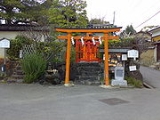
Himegamisha Shrine, Nara
Encyclopedia

Japanese language
is a language spoken by over 130 million people in Japan and in Japanese emigrant communities. It is a member of the Japonic language family, which has a number of proposed relationships with other languages, none of which has gained wide acceptance among historical linguists .Japanese is an...
: 比売神社, Himegamisha) is a Shinto shrine in the city of Nara
Nara, Nara
is the capital city of Nara Prefecture in the Kansai region of Japan. The city occupies the northern part of Nara Prefecture, directly bordering Kyoto Prefecture...
, in Nara Prefecture
Nara Prefecture
is a prefecture in the Kansai region on Honshū Island, Japan. The capital is the city of Nara.-History:The present-day Nara Prefecture was created in 1887, making it independent of Osaka Prefecture....
, Japan
Japan
Japan is an island nation in East Asia. Located in the Pacific Ocean, it lies to the east of the Sea of Japan, China, North Korea, South Korea and Russia, stretching from the Sea of Okhotsk in the north to the East China Sea and Taiwan in the south...
. It is built in 1981 by the people of this neighborhood on the tomb called Hime-zuka (princess' tomb) that is estimated to be a burial place of Princess Tōchi
Princess Tochi
was a Japanese princess during the Asuka period of Japanese history. She was a daughter of Emperor Temmu and the Empress-consort of Emperor Kōbun.-Genealogy:...
, an Empress-consort of Emperor Kōbun
Emperor Kobun
was the 39th emperor of Japan, according to the traditional order of succession.Kōbun's reign lasted only a few months in 671–672.-Traditional narrative:...
. It is a sessha
Setsumatsusha
and , also called are small or miniature shrines having a deep historical relationship with a more important shrine or with the kami it enshrines, and fall under that shrine's jurisdiction. The two terms used to have legally different meanings, but are today synonyms...
(subsidiary shrine) of the Kagami Shrine.
History
In 1930s, the Hime-zuka became nation's property and managed by Nara Bureau of Financial Affairs. Several decades later, this grave was disposed to the residents of this neighborhood. They tried to build a shrine and enshrine Princess TōchiPrincess Tochi
was a Japanese princess during the Asuka period of Japanese history. She was a daughter of Emperor Temmu and the Empress-consort of Emperor Kōbun.-Genealogy:...
to it, for the revival of this area. The 320 square feet (29.7 m²) land was donated to the Shin-Yakushi-ji
Shin-Yakushi-ji
is a Buddhist temple of the Kegon sect in Nara, Japan. It was founded in 747 by Empress Kōmyō. Initially a large complete Shichidō garan temple, it suffered from fire damage and deteriorated during the Heian period. The temple was revived during the Kamakura period. Only one building, the present...
temple, and the Shinto
Shinto
or Shintoism, also kami-no-michi, is the indigenous spirituality of Japan and the Japanese people. It is a set of practices, to be carried out diligently, to establish a connection between present day Japan and its ancient past. Shinto practices were first recorded and codified in the written...
ceremonies to be held in the shrine were delegated to the chief priest of the Kagami Shrine.
A ground-breaking ceremony was held in the summer of 1980, and a roof-laying ceremony in the end of that year, in cooperation with the Shin Yakushiji Temple and the Kagami Shrine. The shrine building was completed. The celebrating ceremony of enshrinement was held on May 10, 1981, which was the day converted to the solar calendar of the 7th Day of the 4th Month, when the princess died. That was how the shrine was founded.

